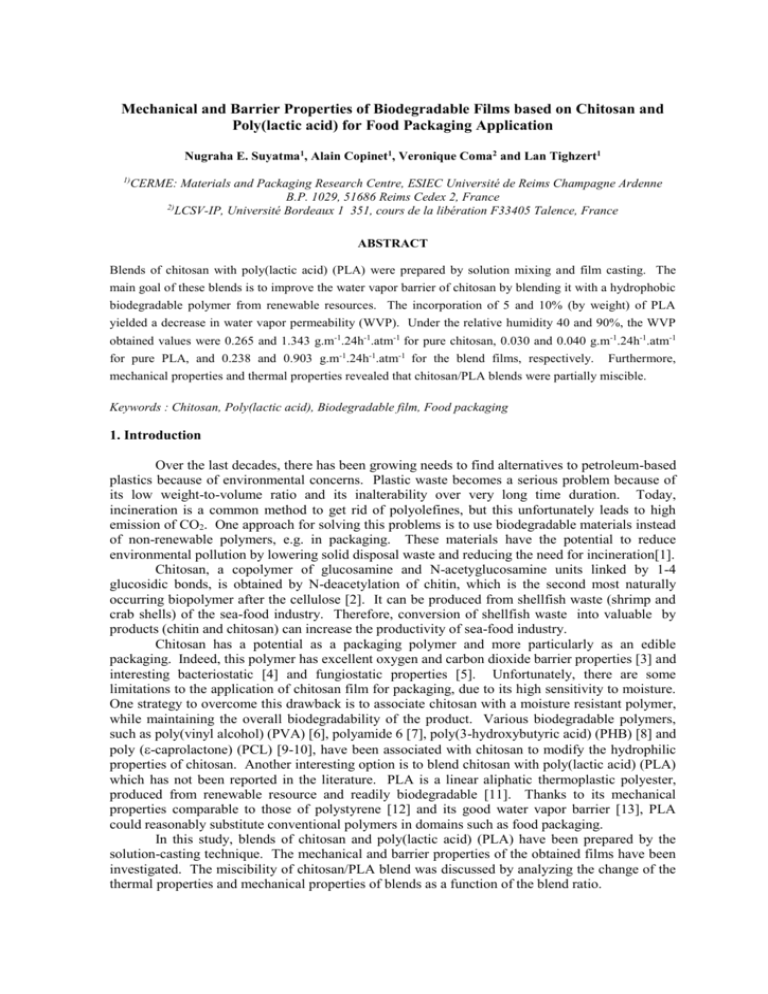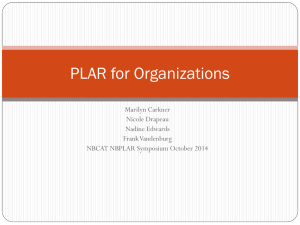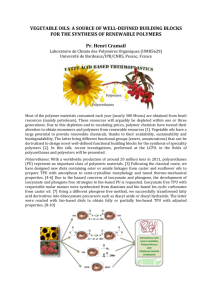Mechanical and Barrier Properties of
advertisement

Mechanical and Barrier Properties of Biodegradable Films based on Chitosan and Poly(lactic acid) for Food Packaging Application Nugraha E. Suyatma1, Alain Copinet1, Veronique Coma2 and Lan Tighzert1 1) CERME: Materials and Packaging Research Centre, ESIEC Université de Reims Champagne Ardenne B.P. 1029, 51686 Reims Cedex 2, France 2) LCSV-IP, Université Bordeaux 1 351, cours de la libération F33405 Talence, France ABSTRACT Blends of chitosan with poly(lactic acid) (PLA) were prepared by solution mixing and film casting. The main goal of these blends is to improve the water vapor barrier of chitosan by blending it with a hydrophobic biodegradable polymer from renewable resources. The incorporation of 5 and 10% (by weight) of PLA yielded a decrease in water vapor permeability (WVP). Under the relative humidity 40 and 90%, the WVP obtained values were 0.265 and 1.343 g.m-1.24h-1.atm-1 for pure chitosan, 0.030 and 0.040 g.m-1.24h-1.atm-1 for pure PLA, and 0.238 and 0.903 g.m-1.24h-1.atm-1 for the blend films, respectively. Furthermore, mechanical properties and thermal properties revealed that chitosan/PLA blends were partially miscible. Keywords : Chitosan, Poly(lactic acid), Biodegradable film, Food packaging 1. Introduction Over the last decades, there has been growing needs to find alternatives to petroleum-based plastics because of environmental concerns. Plastic waste becomes a serious problem because of its low weight-to-volume ratio and its inalterability over very long time duration. Today, incineration is a common method to get rid of polyolefines, but this unfortunately leads to high emission of CO2. One approach for solving this problems is to use biodegradable materials instead of non-renewable polymers, e.g. in packaging. These materials have the potential to reduce environmental pollution by lowering solid disposal waste and reducing the need for incineration[1]. Chitosan, a copolymer of glucosamine and N-acetyglucosamine units linked by 1-4 glucosidic bonds, is obtained by N-deacetylation of chitin, which is the second most naturally occurring biopolymer after the cellulose [2]. It can be produced from shellfish waste (shrimp and crab shells) of the sea-food industry. Therefore, conversion of shellfish waste into valuable by products (chitin and chitosan) can increase the productivity of sea-food industry. Chitosan has a potential as a packaging polymer and more particularly as an edible packaging. Indeed, this polymer has excellent oxygen and carbon dioxide barrier properties [3] and interesting bacteriostatic [4] and fungiostatic properties [5]. Unfortunately, there are some limitations to the application of chitosan film for packaging, due to its high sensitivity to moisture. One strategy to overcome this drawback is to associate chitosan with a moisture resistant polymer, while maintaining the overall biodegradability of the product. Various biodegradable polymers, such as poly(vinyl alcohol) (PVA) [6], polyamide 6 [7], poly(3-hydroxybutyric acid) (PHB) [8] and poly (-caprolactone) (PCL) [9-10], have been associated with chitosan to modify the hydrophilic properties of chitosan. Another interesting option is to blend chitosan with poly(lactic acid) (PLA) which has not been reported in the literature. PLA is a linear aliphatic thermoplastic polyester, produced from renewable resource and readily biodegradable [11]. Thanks to its mechanical properties comparable to those of polystyrene [12] and its good water vapor barrier [13], PLA could reasonably substitute conventional polymers in domains such as food packaging. In this study, blends of chitosan and poly(lactic acid) (PLA) have been prepared by the solution-casting technique. The mechanical and barrier properties of the obtained films have been investigated. The miscibility of chitosan/PLA blend was discussed by analyzing the change of the thermal properties and mechanical properties of blends as a function of the blend ratio. 2. Materials and Methods 2.1. Materials The chitosan used was a commercial material obtained from crab shell (Les Pecheries Marinard, Inc). Its degree of deacetylation was 80-85% determined by colloidal method. PLA was provided as pellets by Cargill-Dow (USA). The average molecular weight of 49,000 was determined by intrinsic viscosity measurements in chloroform at 25°C. The common solvents were acetic acid and acetonitrile purchased from Aldrich (USA). 2.2. Chitosan/PLA blends processing Polymers were dissolved in different solvents before blending: chitosan (1% by weight) in acetic acid 1% and PLA (10% by weight) in acetonitrile. Then two solutions were blended with magnetic stirrer until homogenous solutions were obtained. The blend films were obtained by casting on petri-dishes and evaporating at room temperature for 1-4 days under vacuum. The final film composition (chitosan/PLA) was 100/0; 95/5; 90/10; 0/100 (w/w). 2.3. Tensile testing Tensile testing was carried out on a tensile testing machine (Adamel-Lhomargy, DY25) according to the ASTM D882-91, with a crosshead speed of 10 mm/min. Each sample width and thickness were measured before testing. Ten samples for each blend composition were tested after a 6 week conditioning period at 50% RH and 23°C. Young’s modulus, maximum tensile strength and elongation at break (EB) were obtained. 2.4. Permeability measurement Water vapor transmission rates (WVTR) of films obtained were measured using a MOCON Permatran-W3/31 (Modern Control, Inc., Minneapolis, MN) essentially as desribed in ASTM F1249-90. After conditioning at 50%RH and 23°C for 3 weeks, samples were masked using aluminium foil with an adhesive backing with a test area of 5 cm2. Three %RH were used, 40, 65, and 90%RH. Calibration was performed using Mylar LB92 supplied by MOCON, which had a WVTR of 12.5 g/m2/d at 25°C and 100%RH. 2.5. Thermal analysis Differential scanning calorimetry (M-DSC 2920, TA instruments, USA) was used for the thermal analysis of pure polymers and blends. The samples were sealed in aluminium pans (9-10 mg) and heated from –50 to 200°C at a rate of 10°C/min. A nitrogen flow (50 ml/min) was maintained throughout the test. 3. Results and Discussion Mechanical Properties The mechanical properties of chitosan/PLA blends, as well as of pure components, are shown in Table 1. When looking at the characteristic of pure polymer (compositions 100/0 and 0/100), it can be clearly seen that chitosan has a better performance than PLA. Consequently, all blends showed a marked decrease in the moduli, tensile strength and EB. However, all values range between those of pure polymers, and only the tensile strength of blends show a significant difference compared with pure chitosan. The modulus of polymer blends theoretically lies between an upper limit given by the parallel model: E = 1.E1 + 2.E2 and a lower limit given by the series model: 1/E = 1/E1 + 2/E2 Moreover for a homogenous system, the modulus is given by the Davies model [14]: E1/5 = 1E11/5 + 2.E21/5 Where Ei and i are, respectively , the modulus and volume fraction of the ith phase. Table 3.1. Mechanical properties of chitosan/PLA blends (standard deviation are given in brackets) Composition (w/w) E modulus (MPa) Tensile strength (MPa) EB (%) Chit/PLA : 100/0 510.7a (54.7) 70.3a (4.5) 11,5a (2,1) Chit/PLA : 95/5 451.1ab (12.3) 54.7b (0.6) 9,5a (3,2) ab b Chit/PLA : 90/10 426.3 (17.4) 57.0 (1.6) 9,7a (3,8) b c Chit/PLA : 0/100 372.1 (72.2) 32.1 (1.7) 1,9b (1.9) a-c Different superscript letters within a column indicate significant differences (p=0,05) In Figure 1, the elastic modulus of chitosan/PLA blends were plotted versus the volume fraction of PLA, and compared with the parallel, series and Davies models. The experimental moduli are inferior to the lower limit. It may be inferred that chitosan/PLA blends were not completely miscible. Thermal Properties It is well known that the glass transition temperature (Tg) of a polymer blends is one of the most important criteria for the miscibility of components. The definition for miscible and partially miscible blends have been well established. As far as the binary blends are concerned, if components are completely miscible, only one Tg will appear in DSC thermograms at an intermediate temperature compared to that Tg value of each pure polymer. This Tg of blend should obey the Fox equation describing the relationship between the Tg value of the blend and its composition, as well as Tg values of components in the pure state. If two components are only partially miscible, the Tg value of each component phase should be affected by the other one, and it is usually composition dependent [15]. 0 520 E (exp) E (parallel) E (series) Davies 480 460 -5 Heat Flow (W/g) Elastic modulus (MPa) 500 440 420 400 -10 -15 Tm = 148°C (4) (1) Chit/PLA 100/0 (2) Chit/PLA 95/5 (3) Chit/PLA 90/10 (4) Chit/PLA 0/100 Tm = 152°C (1) -20 (2) (3) 380 Tm = 125°C (2 & 3) 360 0 20 40 60 80 volume fraction of PLA 100 Figure 1. Experimental Young Moduli of chit/PLA blends compared with the models -25 80 Exo Up 100 120 140 160 180 200 Temperature (°C) Figure 2. Melting temperature (T m) in DSC thermograms of chit/PLA blends The thermal properties of chitosan/PLA blends were determined by DSC and the thermograms are presented in Figures 2 and 3. For all compositions an endothermic peak was observed. The melting temperatures of chitosan and PLA are 152 and 148°C, respectively. Two blend compositions chitosan/PLA 95/5 and 90/10 show a decrease in melting temperature at 125°C. This result could indicate that there is a partial miscibility of two initial polymers. Furthermore, chitosan and PLA show a single glass transition temperature at 52 and 59°C, respectively. Since their blends 95/5 and 90/10 show two Tg (45; 56°C and 48; 58°C, respectively) whose values are different from those of chitosan and PLA. Therefore they present a dependence of glass transition temperature on the blend composition, indicating a partial miscibility of starting polymers. 1,4 0 45°C (2) -1 52°C (1) 56°C (2) -3 48°C (3) -4 65% RH 40% RH 1 -1 59°C (4) -2 90% RH 1,2 y = 1,2391 * e^(-0,037227x) R= 0,98456 0,8 y = 0,66039 * e^(-0,028043x) R= 0,98653 -1 Heat Flow (W/g) -1 WVP (g.m .24H .atm ) (1) Chit/PLA 100/0 (2) Chit/PLA 95/5 (3) Chit/PLA 90/10 (4) Chit/PLA 0/100 58°C (3) y = 0,28178 * e^(-0,019414x) R= 0,97385 0,6 0,4 0,2 -5 30 Exo Up 40 50 60 70 80 0 0 Temperature (°C) Fig. 3. Glass transition temperature (T g) in DSC thermograms of chit/PLA blends 20 40 60 80 100 PLA content (wt. %) Figure 4. Effect of the PLA content on the water vapor permeability Water Vapor Permeability (WVP) Figure 4 shows the water vapor permeability (WVP) for Chit/PLA blends as a function of PLA content at various relative humidity (RH). The improvement in water barrier properties with increasing PLA content was substantial at the high RH (65 and 90%) and there was only slight effect of PLA incorporation on the WVP measured at 40% RH (WVP values and ANOVA are given in Table 2). It is suggested that chitosan is very sensitive to moisture and an important improvement in barrier properties is observed even with low concentration of PLA. The decrease in water vapor permeability with increasing PLA content is due to a well known hydrophobicity of PLA. Table 2. Water vapor permeability at various relative humidity a-c Composition (w/w) WVP at 90% RH g.m-1.24H-1.atm-1 WVP at 65% RH g.m-1.24H-1.atm-1 WVP at 40% RH g.m-1.24H-1.atm-1 Chit/PLA : 100/0 Chit/PLA : 95/5 Chit/PLA : 90/10 1,343a ± 0,279 0,903b ± 0,107 0,896b ± 0,119 0,702a ± 0,091 0,511b ± 0,031 0,527b ± 0,079 0,265a ± 0,056 0,238a ± 0,004 0,268a ± 0,047 Chit/PLA : 0/100 0,030c ± 0,003 0,040c ± 0,001 0,040b ± 0,005 Different superscript letters within a column indicate significant differences (p=0,05) 4. Conclusions Chitosan is a promising biodegradable polymer for active food packaging. However, because of its sensitivity to moisture, we have blended it with PLA. The incorporation of PLA improve the water vapor barrier of chitosan mainly under high humidity condition. However, the mechanical characteristics of the blends decreased with the higher PLA contents. All values range between those of pure polymers, indicating a partial compatibility might be achieved between chitosan and PLA. Moreover, this partial compatibility is observed in DSC result. Acknowledgement The authors want to thank Patrice Dole (INRA-Reims, France) and Florence Fricoteaux (ESIEC, Université de Reims) for their help with the characterization experiments. References [1]. Kittur F.S., Kumar, K.R., Tharanathan, R.N. 1998. Functional packaging properties of chitosan films. Z Lebensm Unters Forsch A, 206:44-47 [2]. Lower, S.E. 1984. Polymers from the sea chitin and chitosan. Manufacturing Chemistry, 55:73-75 [3]. Hosokawa, J., Nishiyama, M.,Yoshihara, K., Kubo, T. 1990. Biodegradable film derived from chitosan and homogenized cellulose. Ind. Eng. Chem. Res., 29: 800-805 [4]. Wang, G. 1992. Inhibition and inactivation of five species of foodborne pathogens by chitosan. Journal of Food Protection, 55:916-919 [5]. Roller, S., Covill, N. 1999. The antifungal properties of chitosan in laboratory media and apple juice. International Journal of Food Microbiology, 47: 67-77 [6]. Arvanitoyannis, I., Kolokuris, I., Nakayama, A., Yamamoto, N., Aiba, S. 1997. Physicochemical studies of chitosan-poly(vinyl alcohol) blends plasticized with sorbitol and sucrose. Carbohydrate Polymers, 34: 9-19 [7]. Dufresne, A., Cavaillé, J.Y., Dupeyre, D., Garcia-Ramirez, M. 1999. Morphology, phase continuity and mechanical behavior of polyamide 6 / chitosan blends. Polymer, 40:1657-1666 [8]. Ikejima, T and Inoue, Y. 2000. Crystallization behavior and environmental biodegradability of the blend films of poly(3-hydroxybutiric acid) with chitin and chitosan. Carbohydrat Polymers, 41: 351-356 [9]. Olabarrieta, I., Forsström, D., Gedde, U.W., Hedenqvist, M.S. 2001. Transport properties of chitosan and whey blended with poly(-caprolactone) assesed by standard permeability measurements and microcalorimetry. Polymer, 42: 4401-4408 [10]. Senda, T., He, Y., Inoue, Y. 2001. Biodegradable blends of poly(-caprolactone) with chitin and chitosan: specific interactions, thermal properties and crystallization behavior. Polymer International, 51: 33-39 [11].Tsuji, H., Ikada, Y. 1998. Blends of aliphatic polyesters. II. Hydrolysis of solution-cast blends from poly(L-lactide) and poly(-caprolactone) in phosphate-buffered solution. J. Appl. Polym. Sci., 67:405-415 [12]. Södegard, A. 2000. Lactic acid based polymers for packaging materials for the food industry. Proceeding of the Food Biopack Conference, Copenhagen, Denmark, 27-29 august 2000 [13].Shogren, R. 1997. Water vapor permeability of biodegradable polymers. Journal of Environmental Polymer Degradation, 5 (2): 91-95 [14]. Willemse, R.C., Speijer, A., Langeraar, A.E., Posthuma de Boer, A. 1999. Tensile Moduli of co-continuous polymer blends. Polymer, 40: 6645-6650. [15].Shuai, X., He, Y., Asakawa, N., Inoue, Y. 2001. Miscibility and phase structure of binary blends of poly(L-lactide) and poly(vinyl alcohol). J. Appl. Polym. Sci., 81:762-772.




